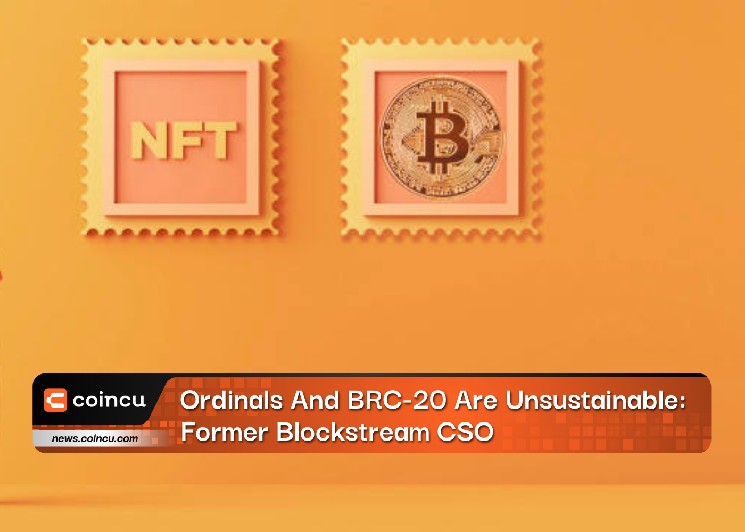Ordinals And BRC-20 Are Unsustainable: Former Blockstream CSO

He stated:
“These guys are basically paying massive amounts of fees that go directly to Bitcoin miners, and there is no way this can be sustained. They will fade away after even months, let’s not talk about years here.”
Bitcoin Ordinals looks to be on the rise and taking over the heyday of Web3. The market has been buzzing since software engineer Casey Rodarmor launched the protocol on January 21. However, user reactions have been quite mixed, with some excited by the new upgrade and others completely rejected.
Since each NFT is minted on one satoshi (1 BTC = 100,000,000 Satoshi), 1 Bitcoin can generate at most 100,000,000 Bitcoin NFTs. These NFTs are trackable, transferable, and work natively on Bitcoin without the need for Layer 2 solutions.
What’s even more striking is that these NFTs are hosted entirely on the Bitcoin network and not on servers different from the majority of NFTs on the market. Ordinals also leveraged Bitcoin’s SegWit 2017 upgrade and Bitcoin’s 2021 Taproot upgrade, which is a technology that helps the network get authenticated faster.
Despite all the notoriety, there are 6,411,426 Ordinals in existence at the time of writing.
Although many members of the Bitcoin community regard Ordinals as a use-case that might increase Bitcoin acceptance, Mow sees them as nothing more than network spam.
“These are just short-term money grabs similar to most things on competing chains like Ethereum and Solana.”
Ordinals are complete in that all data is written directly on the chain. That’s why Rodarmor calls them digital artifacts, not Bitcoin NFTs. Furthermore, NFTs often have creator royalties attached to them, while digital artifacts do not. According to Rodarmor, an Ordinal was born for the purpose of reflecting what the NFT should be, what it is sometimes, and what the nature of the inscriptions has always been.
The BRC-20 token is an experimental fungible token built on top of the Bitcoin Blockchain network using Ordinals and Inscriptions. Simplified, this is a JSON file implemented as a token contract, allowing users to create and transfer tokens.
Compared to tokens created on EVM Blockchains, the BRC-20 standard is quite simple. This is because each token created on the Bitcoin network will cost a lot if the capacity of the Smart Contract is too large. Thus, the BRC-20 standard is simply a script file with a rule that allows the transfer of tokens between different wallets.
Although the BRC-20 market has experienced significant growth in the past 2 months, the standard of this token is still very simple and new compared to ERC-20. The total capitalization of ERC-20 tokens has reached hundreds of billions of dollars, while the capitalization of BRC-20 tokens is only at hundreds of millions.
Mow said that mass adoption of Bitcoin will happen because of its use case as a saving technology and as a means of exchange, not because of “people minting JPEGs and inserting them in the chain.”
DISCLAIMER: The information on this website is provided as general market commentary and does not constitute investment advice. We encourage you to do your own research before investing.






 Bitcoin
Bitcoin  Ethereum
Ethereum  Tether
Tether  USDC
USDC  TRON
TRON  Dogecoin
Dogecoin  Cardano
Cardano  Bitcoin Cash
Bitcoin Cash  Chainlink
Chainlink  Zcash
Zcash  Monero
Monero  LEO Token
LEO Token  Stellar
Stellar  Litecoin
Litecoin  Hedera
Hedera  Dai
Dai  Cronos
Cronos  Tether Gold
Tether Gold  OKB
OKB  Ethereum Classic
Ethereum Classic  KuCoin
KuCoin  Gate
Gate  Algorand
Algorand  Cosmos Hub
Cosmos Hub  VeChain
VeChain  Dash
Dash  Tezos
Tezos  TrueUSD
TrueUSD  Stacks
Stacks  IOTA
IOTA  Decred
Decred  Basic Attention
Basic Attention  Theta Network
Theta Network  NEO
NEO  Synthetix
Synthetix  Qtum
Qtum  Ravencoin
Ravencoin  DigiByte
DigiByte  0x Protocol
0x Protocol  Nano
Nano  Zilliqa
Zilliqa  Holo
Holo  Siacoin
Siacoin  Numeraire
Numeraire  Waves
Waves  Ontology
Ontology  Hive
Hive  Status
Status  BUSD
BUSD  Enjin Coin
Enjin Coin  Pax Dollar
Pax Dollar  Lisk
Lisk  Steem
Steem  Huobi
Huobi  OMG Network
OMG Network  NEM
NEM  Bitcoin Gold
Bitcoin Gold  Augur
Augur  HUSD
HUSD